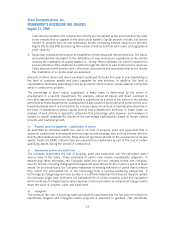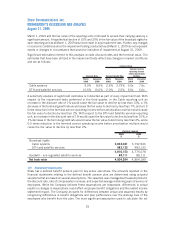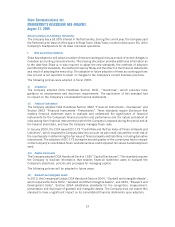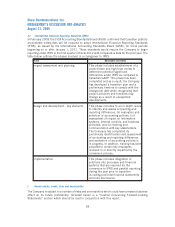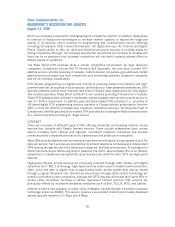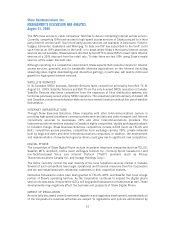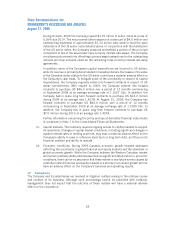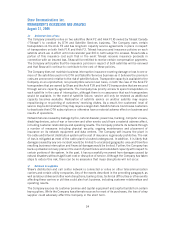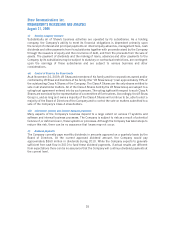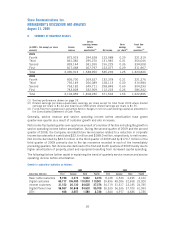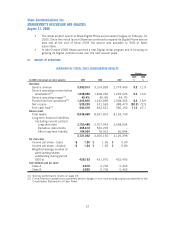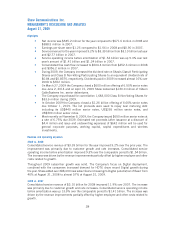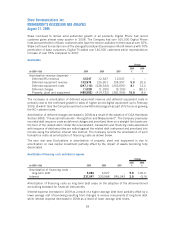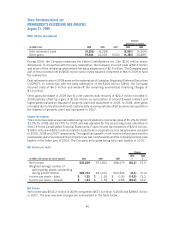Shaw 2009 Annual Report Download - page 35
Download and view the complete annual report
Please find page 35 of the 2009 Shaw annual report below. You can navigate through the pages in the report by either clicking on the pages listed below, or by using the keyword search tool below to find specific information within the annual report.The ISPs have access to cable companies’ facilities to deliver competing Internet access service.
Currently, competing ISPs have access to high-speed access services of Shaw pursuant to a third
party Internet access tariff. Such third party access services are available in Vancouver, Victoria,
Calgary, Edmonton, Saskatoon and Winnipeg. To date one ISP has subscribed to the tariff. Until
such time as an ISP subscribes to the tariff, or in areas where Shaw’s third party Internet access
services are not available, Shaw has been directed by the CRTC to allow ISPs to resell cable Internet
services at a 25% discount from the retail rate. To date there are two ISPs using Shaw’s resale
services at the resale discount rate.
Although operating in a competitive environment, Shaw expects that consumer desire for Internet
access services, generally, and for bandwidth-intensive applications on the Internet (including
streaming video, digital downloading and interactive gaming), in particular, will lead to continued
growth for high-speed Internet services.
SATELLITE SERVICES
In its Canadian SRDU business, Satellite Services faces competition principally from Bell TV. At
August 31, 2009, Satellite Services and Bell TV are the only licensed SRDU operators in Canada.
Satellite Services also faces competition from the expansion of fibre distribution systems into
territories previously served only by SRDU operators. This expansion permits delivery of distant US
and Canadian conventional television stations to more remote locations without the use of satellite
transmission.
INTERNET INFRASTRUCTURE
Through Shaw Business Solutions, Shaw competes with other telecommunications carriers in
providing high-speed broadband communications services (data and video transport and Internet
connectivity services) to businesses, ISPs and other telecommunications providers. The
telecommunications services industry in Canada is highly competitive, rapidly evolving and subject
to constant change. Shaw Business Solutions competitors include ILECS (such as TELUS and
Bell), competitive access providers, competitive local exchange carriers, ISPs, private networks
built by large end users and other telecommunications companies. In addition, the development
and implementation of new technologies by others could give rise to significant new competitors.
DIGITAL PHONE
The competitors of Shaw Digital Phone include incumbent telephone companies (such as TELUS,
SaskTel, MTS, and Bell), CLECs (such as Rogers Telecom Inc., formerly Sprint Canada Inc.) and
non-facilities-based Voice over Internet Protocol (“VoIP”) providers (such as Primus
Telecommunications Canada Inc. and Vonage Holdings Corp.).
The ILECs currently control the vast majority of the local telephone services market in Canada.
Several of such competitors have larger operational and financial resources than the Corporation
and are well established with residential customers in their respective markets.
Numerous forbearance orders have been granted to TELUS, MTS, and SaskTel that cover a large
portion of Shaw’s operating territory. As the Corporation continues to expand the digital phone
service into new areas, it expects the ILECs will be granted forbearance in those areas as well. These
developments may negatively affect the business and prospects of Shaw Digital Phone.
IMPACT OF REGULATION
As more fully discussed under Government regulation and regulatory development, substantially all
of the Corporation’s business activities are subject to regulations and policies administered by
31
Shaw Communications Inc.
MANAGEMENT’S DISCUSSION AND ANALYSIS
August 31, 2009




